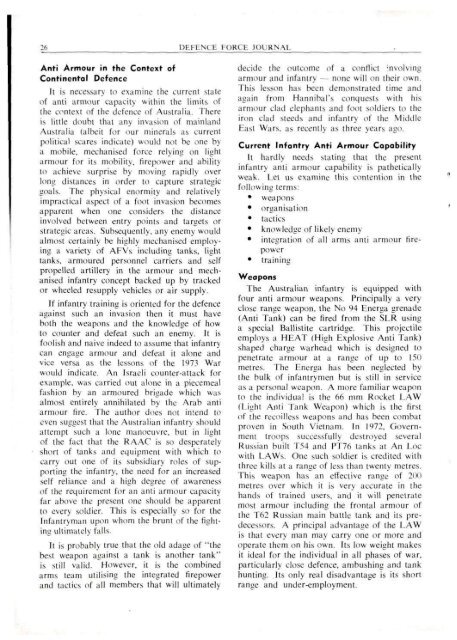ISSUE 1 : Nov/Dec - 1976 - Australian Defence Force Journal
ISSUE 1 : Nov/Dec - 1976 - Australian Defence Force Journal
ISSUE 1 : Nov/Dec - 1976 - Australian Defence Force Journal
Create successful ePaper yourself
Turn your PDF publications into a flip-book with our unique Google optimized e-Paper software.
26 DEFENCE FORCE JOURNALAnti Armour in the Context ofContinental <strong>Defence</strong>It is necessary to examine the current stateof anti armour capacity within the limits ofthe context of the defence of Australia. Thereis little doubt that any invasion of mainlandAustralia (albeit for our minerals as currentpolitical scares indicate) would not be one bya mobile, mechanised force relying on lightarmour for its mobility, firepower and abilitsto achieve surprise by moving rapidly overlong distances in order to capture strategicgoals. The physical enormity and relativelyimpractical aspect of a foot invasion becomesapparent when one considers the distanceinvolved between entry points and targets orstrategic areas. Subsequently, any enemy wouldalmost certainly be highly mechanised employinga variety of AFVs including tanks, lighttanks, armoured personnel carriers and selfpropelled artillery in the armour and mechanisedinfantry concept backed up by trackedor wheeled resupply vehicles or air supply.If infantry training is oriented for the defenceagainst such an invasion then it must haveboth the weapons and the knowledge of howto counter and defeat such an enemy. It isfoolish and naive indeed to assume that infantrycan engage armour and defeat it alone andvice versa as the lessons of the 1973 Warwould indicate. An Israeli counter-attack forexample, was carried out alone in a piecemealfashion by an armoured brigade which wasalmost entirely annihilated by the Arab antiarmour fire. The author does not intend toeven suggest that the <strong>Australian</strong> infantry shouldattempt such a lone manoeuvre, but in lightof the fact that the RAAC is so desperatelyshort of tanks and equipment with which tocarry out one of its subsidiary roles of supportingthe infantry, the need for an increasedself reliance and a high degree of awarenessof the requirement for an anti armour capacityfar above the present one should be apparentto every soldier. This is especially so for theInfantryman upon whom the brunt of the fightingultimately falls.It is probably true that the old adage of "thebest weapon against a tank is another tank"is still valid. However, it is the combinedarms team utilising the integrated firepowerand tactics of all members that will ultimatelydecide the outcome of a conflict: nvoIvingarmour and infantry - none will on their own.This lesson has been demonstrated time andagain from Hannibal's conquests with hisarmour clad elephants and foot soldiers to theiron clad steeds and infantry of the MiddleEast Wars, as recently as three years ago.Current Infantry Anti Armour CapabilityIt hardly needs stating that the presentinfantry anti armour capability is patheticallyweak. Let us examine this contention in thefollowing terms:• weapons• organisation• tactics• knowledge of likely enenn• integration of all arms anti armour firepower• trainingWeaponsThe <strong>Australian</strong> infantry is equipped withfour anti armour weapons. Principally a veryclose range weapon, the No 94 Energa grenade(Anti Tank) can be fired from the SLR usinga special Ballistite cartridge. This projectileemploys a HEAT (High Explosive Anti Tank)shaped charge warhead which is designed topenetrate armour at a range of up to 150metres. The Energa has been neglected bythe bulk of infantrymen but is still in serviceas a personal weapon. A more familiar weaponto the individual is the 66 mm Rocket LAW(Light Anti Tank Weapon) which is the firstof the recoilless weapons and has been combatproven in South Vietnam. In 1972, Governmenttroops successfully destroyed severalRussian built T54 and PT76 tanks at An Locwith LAWs. One such soldier is credited withthree kills at a range of less than twenty metres.This weapon has an effective range of 200metres over which it is very accurate in thehands of trained users, and it will penetratemost armour including the frontal armour ofthe T62 Russian main battle tank and its predecessors.A principal advantage of the LAWis that every man may carry one or more andoperate them on his own. Its low weight makesit ideal for the individual in all phases of war,particularly close defence, ambushing and tankhunting. Its only real disadvantage is its shortrange and under-employment.
















